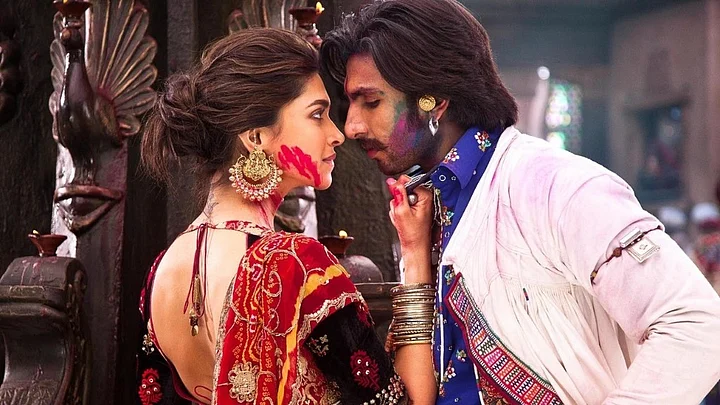While in the good old days, no Hindi film was complete without a Holi song, gradually the cinema goer seems to have got disenchanted with the festival of colours. But a decade ago, filmmaker Vipul Shah combined it with fun as Priyanka Chopra and Akshay Kumar flirted with each other while dancing to Do me a favour let’s play holi … in Waqt – The Race against Time (2005).
Soon we had hero Dhanush splash a range of colors on his beloved Sonam Kapoor in Ranjhanaa followed by Ranbir Kapoor- Deepika Padukone drenching each other with champagne for Balam Pichkari… in Yeh Jawani Hai Deewani (2013) and an energetic Deepika -Ranveer Singh living it up to the fullest in Sanjay Leela Bhansali’s Ramleela (2013).
Every festival is associated with a story from mythology. It’s believed that king Hiranyakashapu disapproved of his son Prahlad for being a devotee of Lord Vasudev and wanted him to worship his father as a deity. When that did not happen, the king tried to slay Prahlad but every time Prahlad was miraculously saved by his Lord. Exasperated, Hiranyakashapu sent for his sister Holika blessed with a boon of immortality by Lord Vasudev and Holika sat on the pyre with little Prahlad in her lap.
To everyone’s surprise, while Prahlad remained unscathed by the rising flames, aunt Holika was reduced to ashes and Lord Vasudev emerged from the fire to say that since Holika had misused the boon granted to her, he had to punish her. Ever since, the festival of Holi is celebrated to mark the end of evil, while dhudeti, the ritual of spreading colour on the following day is a robust gesture to soothe the angry flames.
It’s said that the deities in Dwarpar Yug sprinkled kesuda (red flower) mixed with water to calm the ravaging angry flames. Over the centuries, the kings and the queens replaced the red leaf paste with red powder (gulal) and as years passed by we added multiple colours but the message remained the same – it was a festival of spirit and cheer!
In cinema, the festival is even more magical and that’s because different filmmakers lend different perspectives. So if Are jaa re jaa natkhat, mat chuna mera ghunghat… picturised on dancer Gopi Krishna and Sandhya in Navrang (1959) is a celebration of dance for V Shantaram...
Yash Chopra used Rang barse… to revive romance in Silsila (1981) and Ang se ang lagana… to evoke conflict in the Shah Rukh Khan - Juhi Chawla starrer Darr (1993)
For Subhash Ghai, it was a moment of confrontation between Shammi Kapoor and Jackie Shroff in Hero (1983) and reconciliation between two warring friends in Saudagar (1991).
For Rajkumar Santoshi it was a reason to play truant in Damini (1993) and for Ramesh Sippy a moment of celebration in Sholay (1975).
The director combines a happy and a sad moment, where we watch a younger Jaya Bhaduri chasing her to-be father-in-law Sanjeev Kumar’s tonga challenging to colour his spotless kurta and juxtaposes it with Jaya as a widow watching the gaiety from a temple perched on the top of a hill in Ramgarh.
Mani Ratnam’s Tamil film Dalpathi (1991) retold the story of Kunti and Karna in modern times. A 13-year-old, suffering labour pangs delivers a baby hiding in a cowshed. At a distance the villagers are prancing around a bonfire of burning fallen branches. The unmarried girl has no choice but to abandon her newborn on a moving train. For 30 years, the guilty mother tours temples. Every Holi night, Srividya is hounded by ghosts of the past till she meets Rajnikanth and is redeemed when he forgives her.
Often the festival became a dramatic moment to build or break a relationship as in the case of Phagun (1973) where a helpless Waheeda Rehman is obliged to humiliate her husband (Dharmendra) in the presence of people, to pacify her angry father while her husband is crestfallen. He walks out on his pregnant wife, to return only 20 years later, after he has collected a shop full of sarees for his wife.
Remember Naseerudin Shah in Shyam Benegal’s Bhumika (1977)? Where he played a filmmaker who disapproves of celebrations, but his heroine, Smita Patil ignores all warnings and colours him and this becomes the beginning of a new flirtation.
The stigma of a widow participating in the festivities of Holi was challenged by filmmaker Shakti Samanta in Kati Patang (1970), when Rajesh Khanna applies the shagun ka tikka to the young widow. Also exploring unfamiliar nuances was Ketan Mehta’s Holi, which was about ragging in college campuses and told of a tragic story of a young boy’s life destroyed by peer pressure.
(This article is from The Quint’s archives and was first published on March 25, 2016. It is now being republished to mark the festival of Holi.)
(At The Quint, we question everything. Play an active role in shaping our journalism by becoming a member today.)
